A Comprehensive Report: Indigenous Culture's Influence in Sydney
VerifiedAdded on 2021/04/17
|13
|1443
|40
Report
AI Summary
This report provides a comprehensive overview of the influence of Indigenous culture in Sydney, Australia. It begins with an introduction to the importance of cultural identity and its impact on the community. The report acknowledges the Gadigal of the EORA nation as the traditional custodians of Sydney and discusses the involvement of traditional people in various community programs. It delves into the demographics of the Aboriginal population in Sydney, highlighting their marital status, educational advancements, and language diversity. The report further explores indigenous services, significant places displaying Aboriginal culture, and key members contributing to the community. Additionally, it examines Aboriginal organizations in Sydney and their role in preserving and promoting traditional heritage. The report concludes by emphasizing the importance of integrating Indigenous culture with the broader community for economic benefits and offers valuable insights into the Aboriginal culture and its characteristics in Australia.
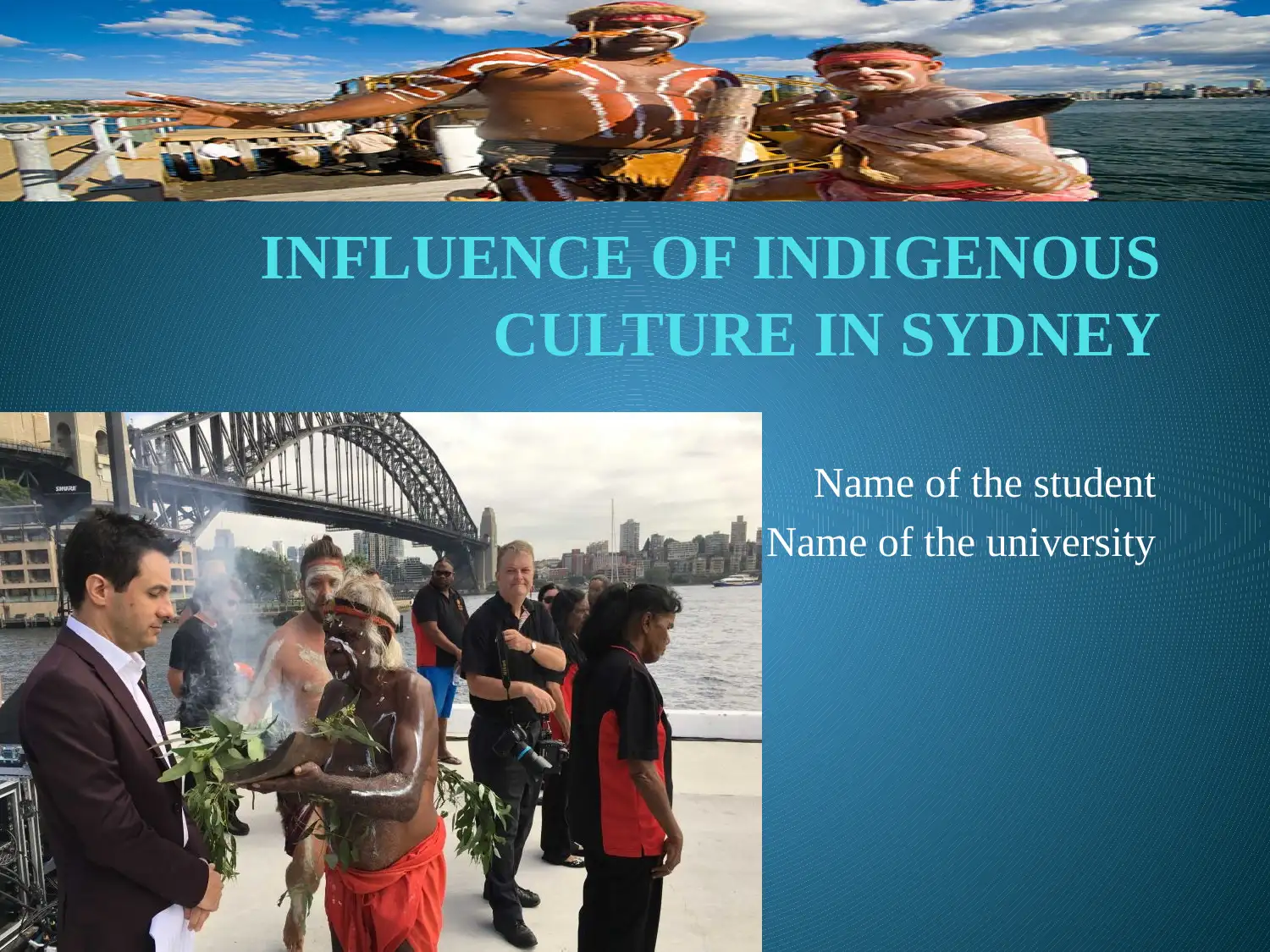
INFLUENCE OF INDIGENOUS
CULTURE IN SYDNEY
Name of the student
Name of the university
CULTURE IN SYDNEY
Name of the student
Name of the university
Paraphrase This Document
Need a fresh take? Get an instant paraphrase of this document with our AI Paraphraser
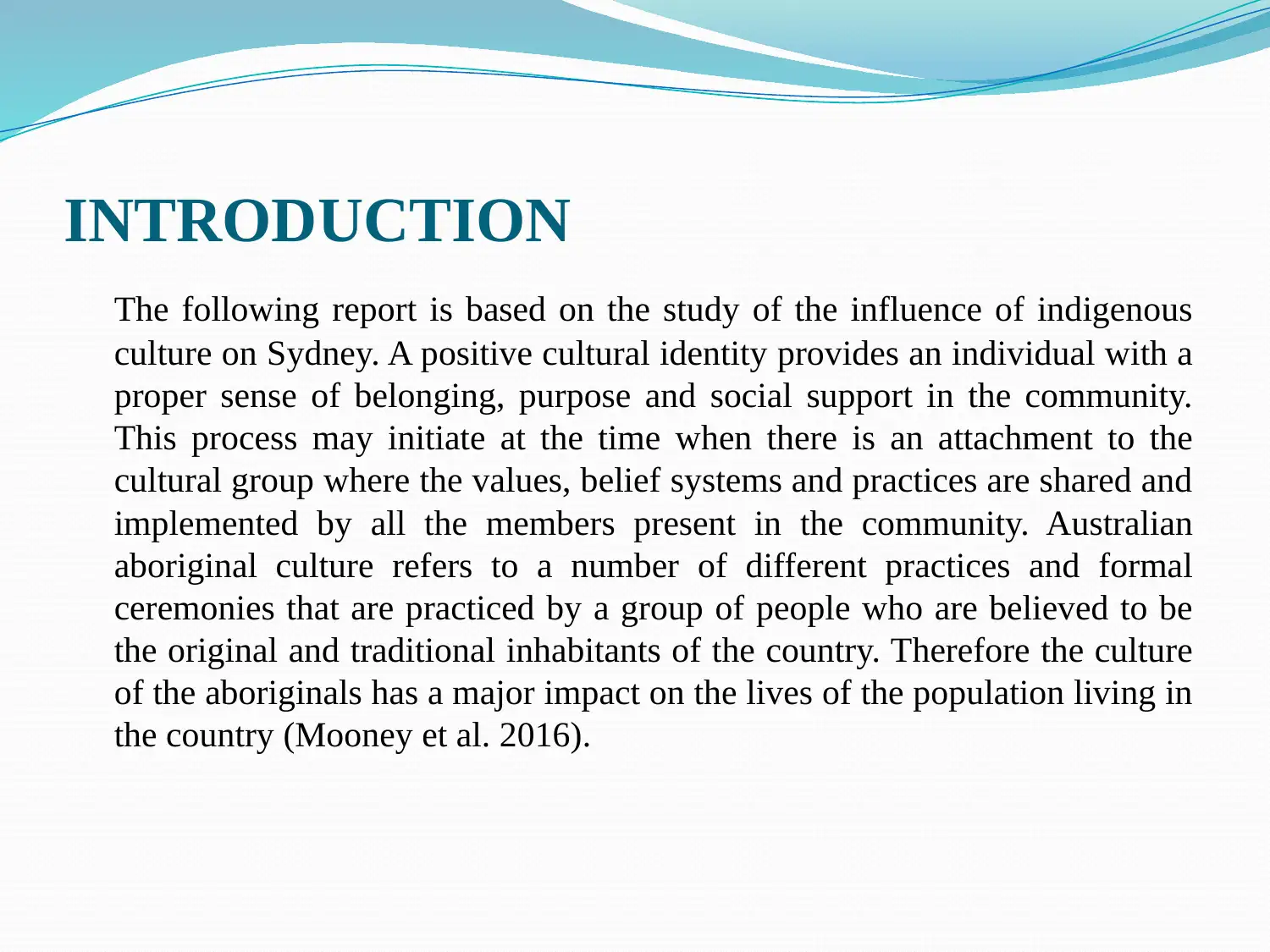
INTRODUCTION
The following report is based on the study of the influence of indigenous
culture on Sydney. A positive cultural identity provides an individual with a
proper sense of belonging, purpose and social support in the community.
This process may initiate at the time when there is an attachment to the
cultural group where the values, belief systems and practices are shared and
implemented by all the members present in the community. Australian
aboriginal culture refers to a number of different practices and formal
ceremonies that are practiced by a group of people who are believed to be
the original and traditional inhabitants of the country. Therefore the culture
of the aboriginals has a major impact on the lives of the population living in
the country (Mooney et al. 2016).
The following report is based on the study of the influence of indigenous
culture on Sydney. A positive cultural identity provides an individual with a
proper sense of belonging, purpose and social support in the community.
This process may initiate at the time when there is an attachment to the
cultural group where the values, belief systems and practices are shared and
implemented by all the members present in the community. Australian
aboriginal culture refers to a number of different practices and formal
ceremonies that are practiced by a group of people who are believed to be
the original and traditional inhabitants of the country. Therefore the culture
of the aboriginals has a major impact on the lives of the population living in
the country (Mooney et al. 2016).
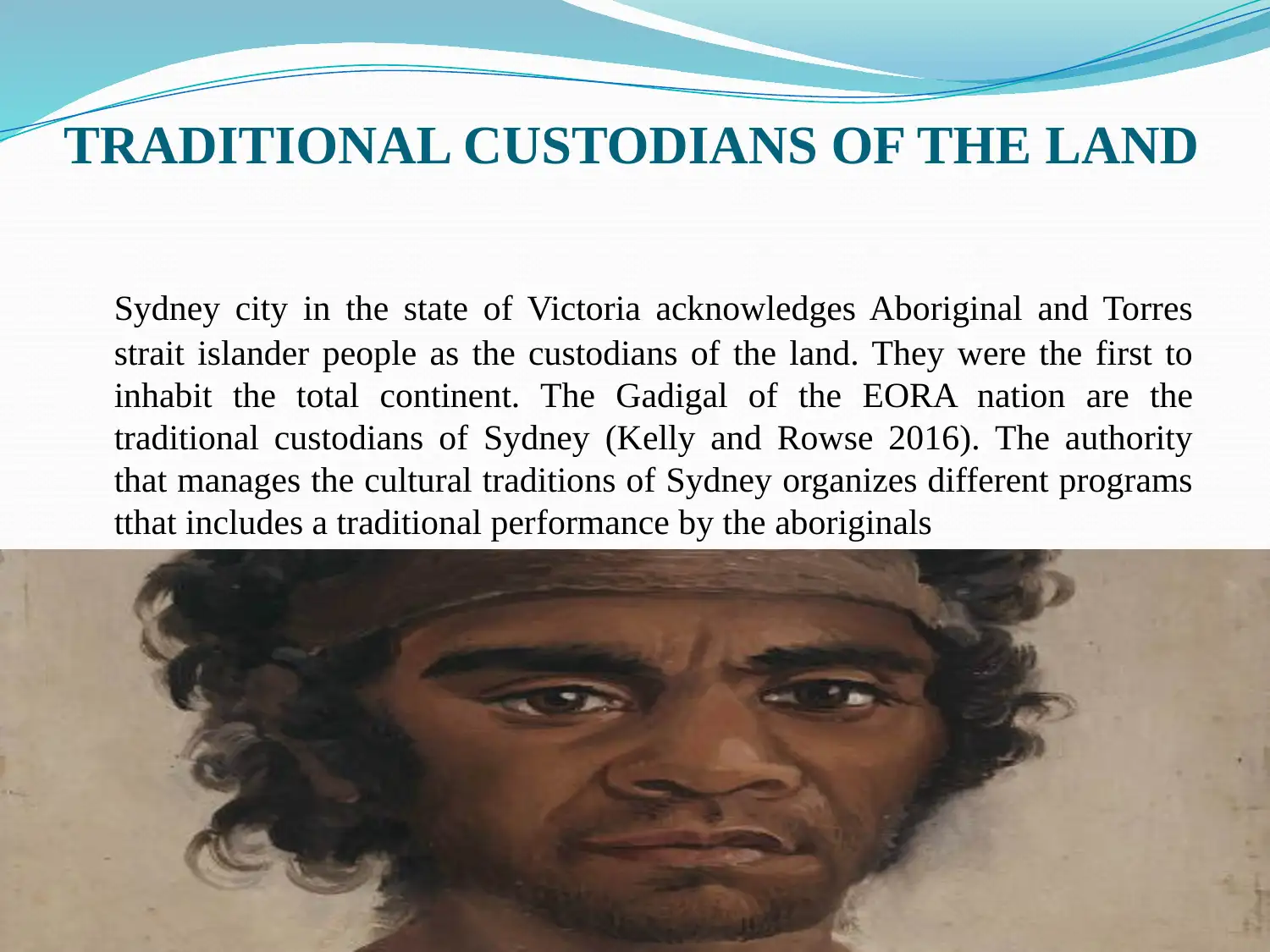
TRADITIONAL CUSTODIANS OF THE LAND
Sydney city in the state of Victoria acknowledges Aboriginal and Torres
strait islander people as the custodians of the land. They were the first to
inhabit the total continent. The Gadigal of the EORA nation are the
traditional custodians of Sydney (Kelly and Rowse 2016). The authority
that manages the cultural traditions of Sydney organizes different programs
tthat includes a traditional performance by the aboriginals
Sydney city in the state of Victoria acknowledges Aboriginal and Torres
strait islander people as the custodians of the land. They were the first to
inhabit the total continent. The Gadigal of the EORA nation are the
traditional custodians of Sydney (Kelly and Rowse 2016). The authority
that manages the cultural traditions of Sydney organizes different programs
tthat includes a traditional performance by the aboriginals
⊘ This is a preview!⊘
Do you want full access?
Subscribe today to unlock all pages.

Trusted by 1+ million students worldwide
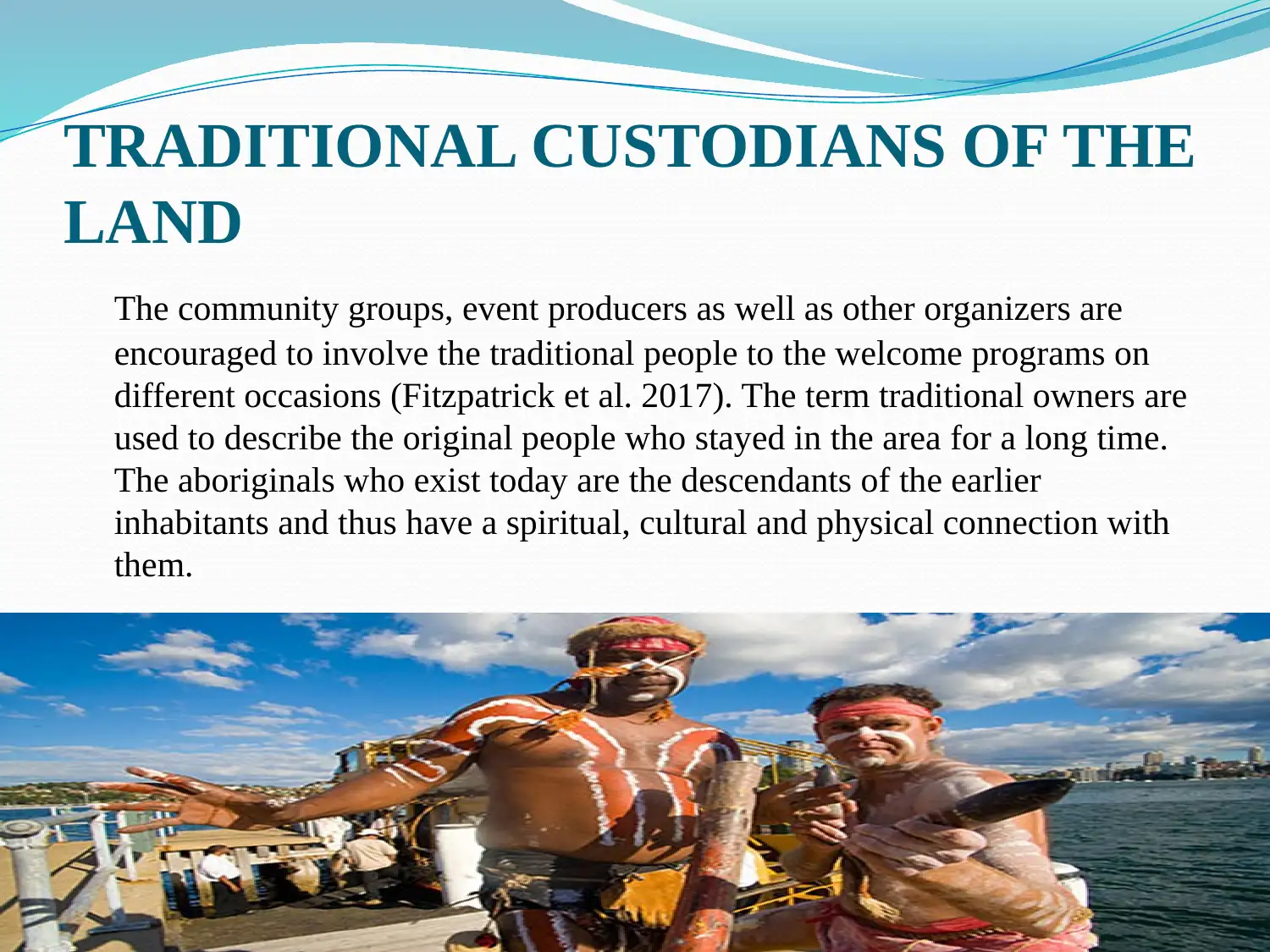
TRADITIONAL CUSTODIANS OF THE
LAND
The community groups, event producers as well as other organizers are
encouraged to involve the traditional people to the welcome programs on
different occasions (Fitzpatrick et al. 2017). The term traditional owners are
used to describe the original people who stayed in the area for a long time.
The aboriginals who exist today are the descendants of the earlier
inhabitants and thus have a spiritual, cultural and physical connection with
them.
LAND
The community groups, event producers as well as other organizers are
encouraged to involve the traditional people to the welcome programs on
different occasions (Fitzpatrick et al. 2017). The term traditional owners are
used to describe the original people who stayed in the area for a long time.
The aboriginals who exist today are the descendants of the earlier
inhabitants and thus have a spiritual, cultural and physical connection with
them.
Paraphrase This Document
Need a fresh take? Get an instant paraphrase of this document with our AI Paraphraser
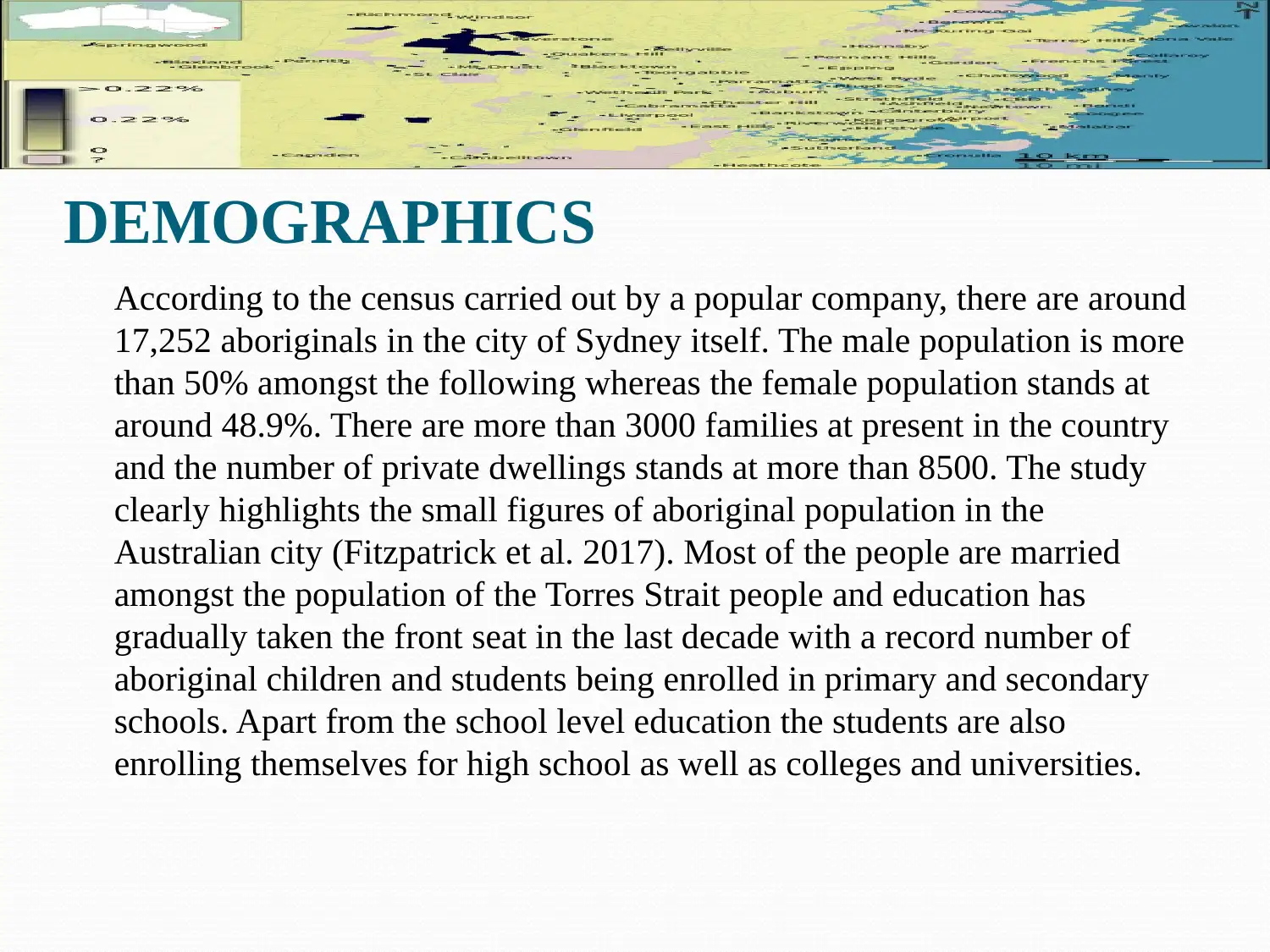
DEMOGRAPHICS
According to the census carried out by a popular company, there are around
17,252 aboriginals in the city of Sydney itself. The male population is more
than 50% amongst the following whereas the female population stands at
around 48.9%. There are more than 3000 families at present in the country
and the number of private dwellings stands at more than 8500. The study
clearly highlights the small figures of aboriginal population in the
Australian city (Fitzpatrick et al. 2017). Most of the people are married
amongst the population of the Torres Strait people and education has
gradually taken the front seat in the last decade with a record number of
aboriginal children and students being enrolled in primary and secondary
schools. Apart from the school level education the students are also
enrolling themselves for high school as well as colleges and universities.
According to the census carried out by a popular company, there are around
17,252 aboriginals in the city of Sydney itself. The male population is more
than 50% amongst the following whereas the female population stands at
around 48.9%. There are more than 3000 families at present in the country
and the number of private dwellings stands at more than 8500. The study
clearly highlights the small figures of aboriginal population in the
Australian city (Fitzpatrick et al. 2017). Most of the people are married
amongst the population of the Torres Strait people and education has
gradually taken the front seat in the last decade with a record number of
aboriginal children and students being enrolled in primary and secondary
schools. Apart from the school level education the students are also
enrolling themselves for high school as well as colleges and universities.
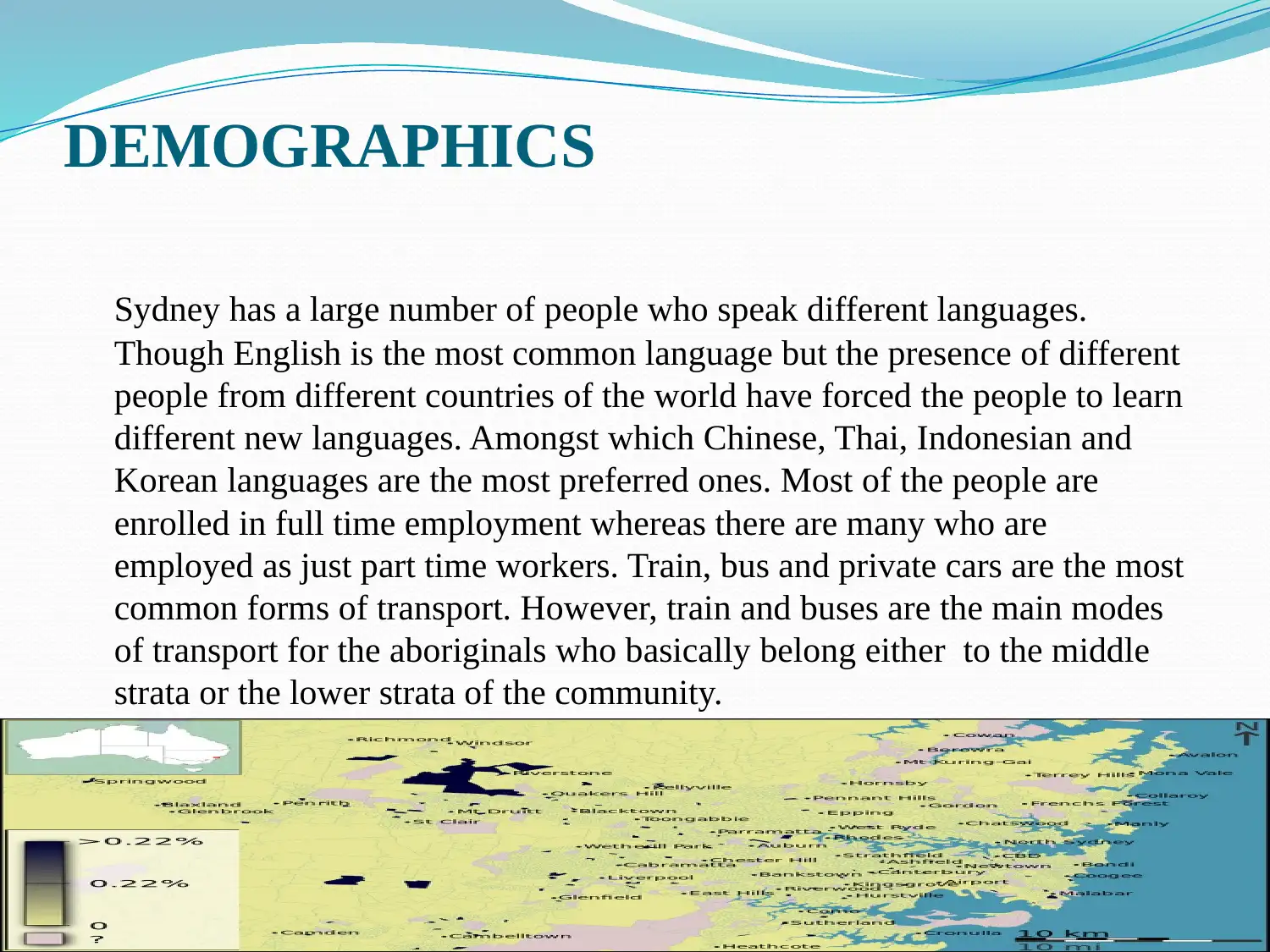
DEMOGRAPHICS
Sydney has a large number of people who speak different languages.
Though English is the most common language but the presence of different
people from different countries of the world have forced the people to learn
different new languages. Amongst which Chinese, Thai, Indonesian and
Korean languages are the most preferred ones. Most of the people are
enrolled in full time employment whereas there are many who are
employed as just part time workers. Train, bus and private cars are the most
common forms of transport. However, train and buses are the main modes
of transport for the aboriginals who basically belong either to the middle
strata or the lower strata of the community.
Sydney has a large number of people who speak different languages.
Though English is the most common language but the presence of different
people from different countries of the world have forced the people to learn
different new languages. Amongst which Chinese, Thai, Indonesian and
Korean languages are the most preferred ones. Most of the people are
enrolled in full time employment whereas there are many who are
employed as just part time workers. Train, bus and private cars are the most
common forms of transport. However, train and buses are the main modes
of transport for the aboriginals who basically belong either to the middle
strata or the lower strata of the community.
⊘ This is a preview!⊘
Do you want full access?
Subscribe today to unlock all pages.

Trusted by 1+ million students worldwide
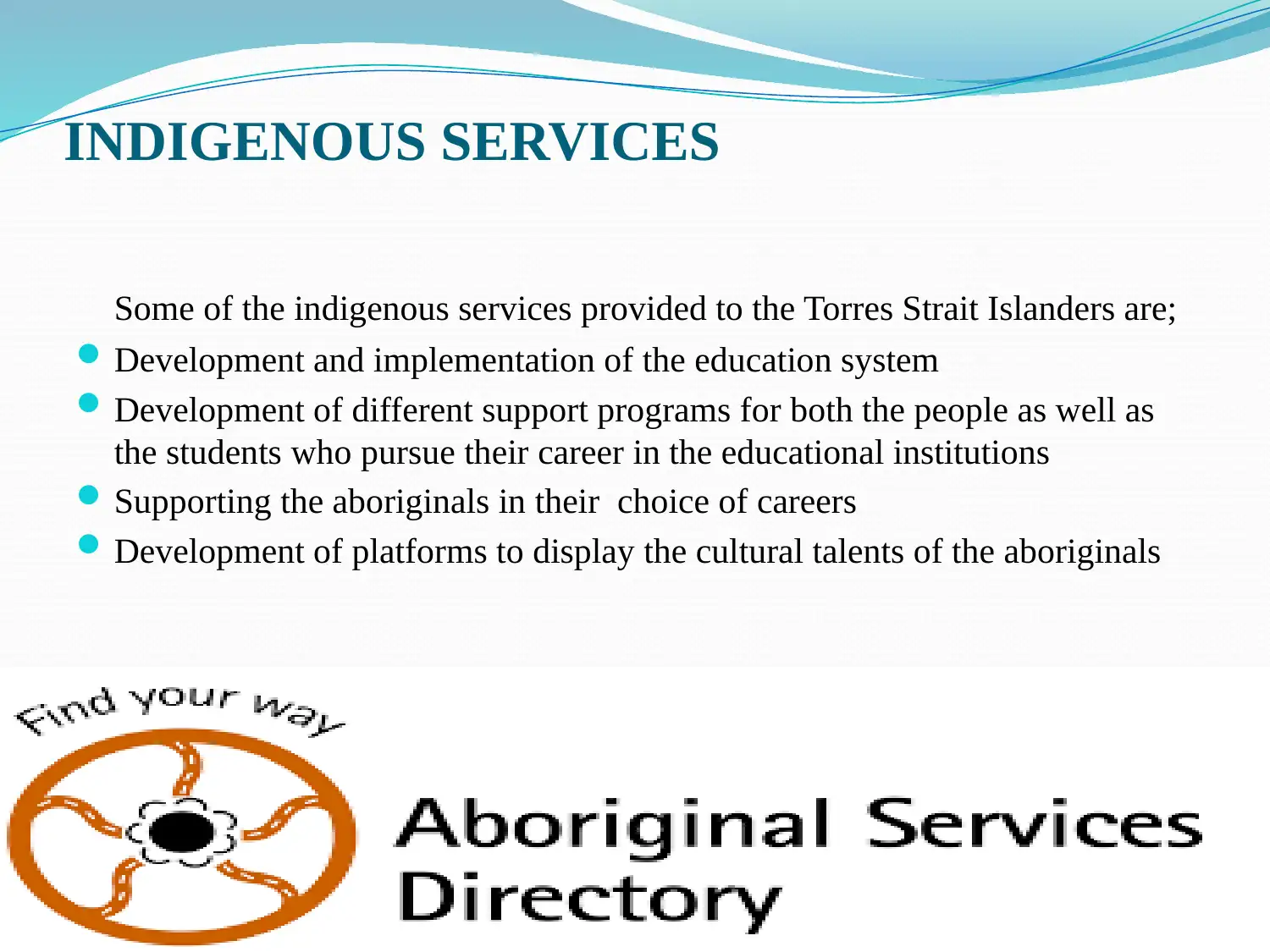
INDIGENOUS SERVICES
Some of the indigenous services provided to the Torres Strait Islanders are;
Development and implementation of the education system
Development of different support programs for both the people as well as
the students who pursue their career in the educational institutions
Supporting the aboriginals in their choice of careers
Development of platforms to display the cultural talents of the aboriginals
Some of the indigenous services provided to the Torres Strait Islanders are;
Development and implementation of the education system
Development of different support programs for both the people as well as
the students who pursue their career in the educational institutions
Supporting the aboriginals in their choice of careers
Development of platforms to display the cultural talents of the aboriginals
Paraphrase This Document
Need a fresh take? Get an instant paraphrase of this document with our AI Paraphraser
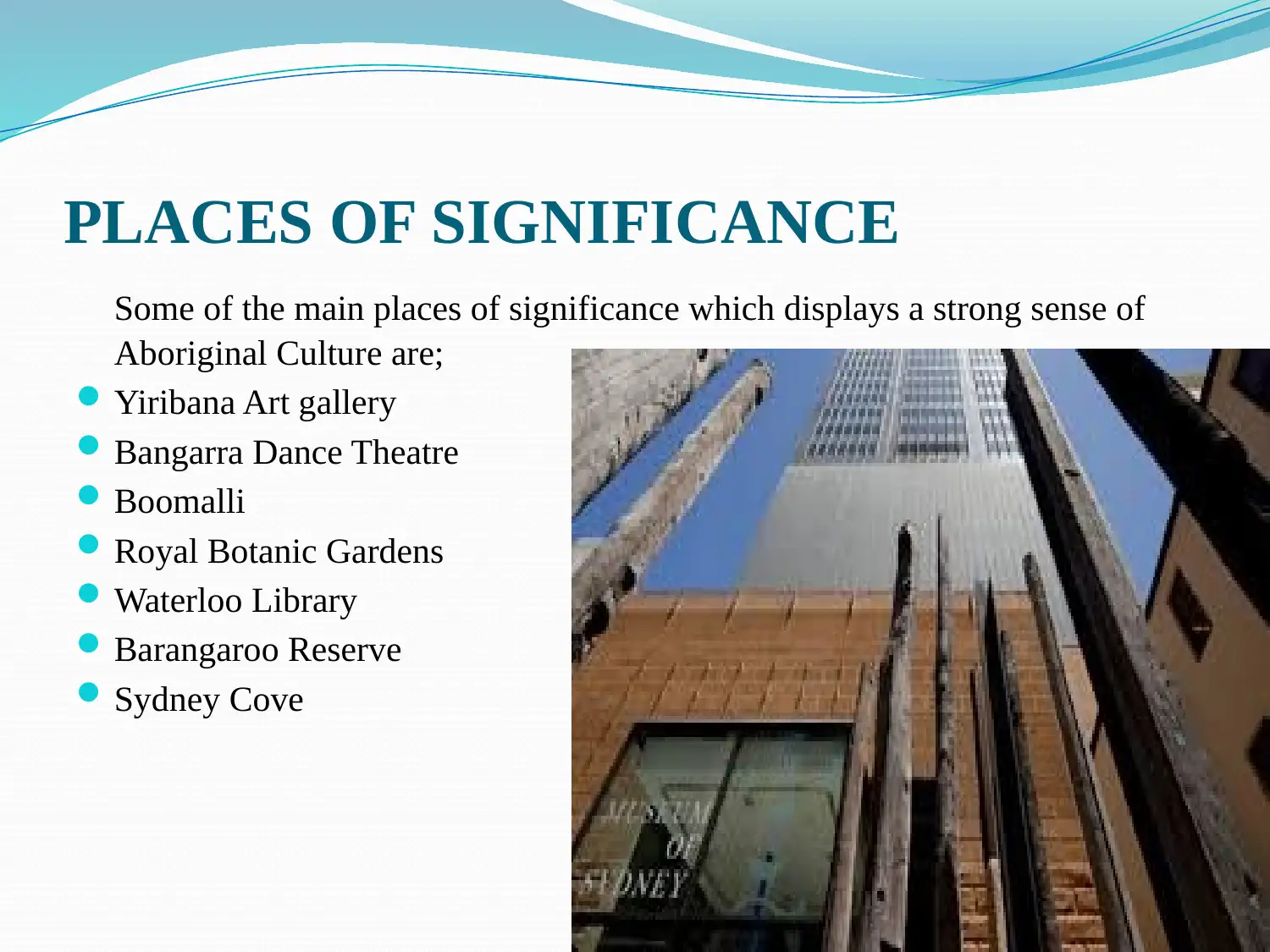
PLACES OF SIGNIFICANCE
Some of the main places of significance which displays a strong sense of
Aboriginal Culture are;
Yiribana Art gallery
Bangarra Dance Theatre
Boomalli
Royal Botanic Gardens
Waterloo Library
Barangaroo Reserve
Sydney Cove
Some of the main places of significance which displays a strong sense of
Aboriginal Culture are;
Yiribana Art gallery
Bangarra Dance Theatre
Boomalli
Royal Botanic Gardens
Waterloo Library
Barangaroo Reserve
Sydney Cove
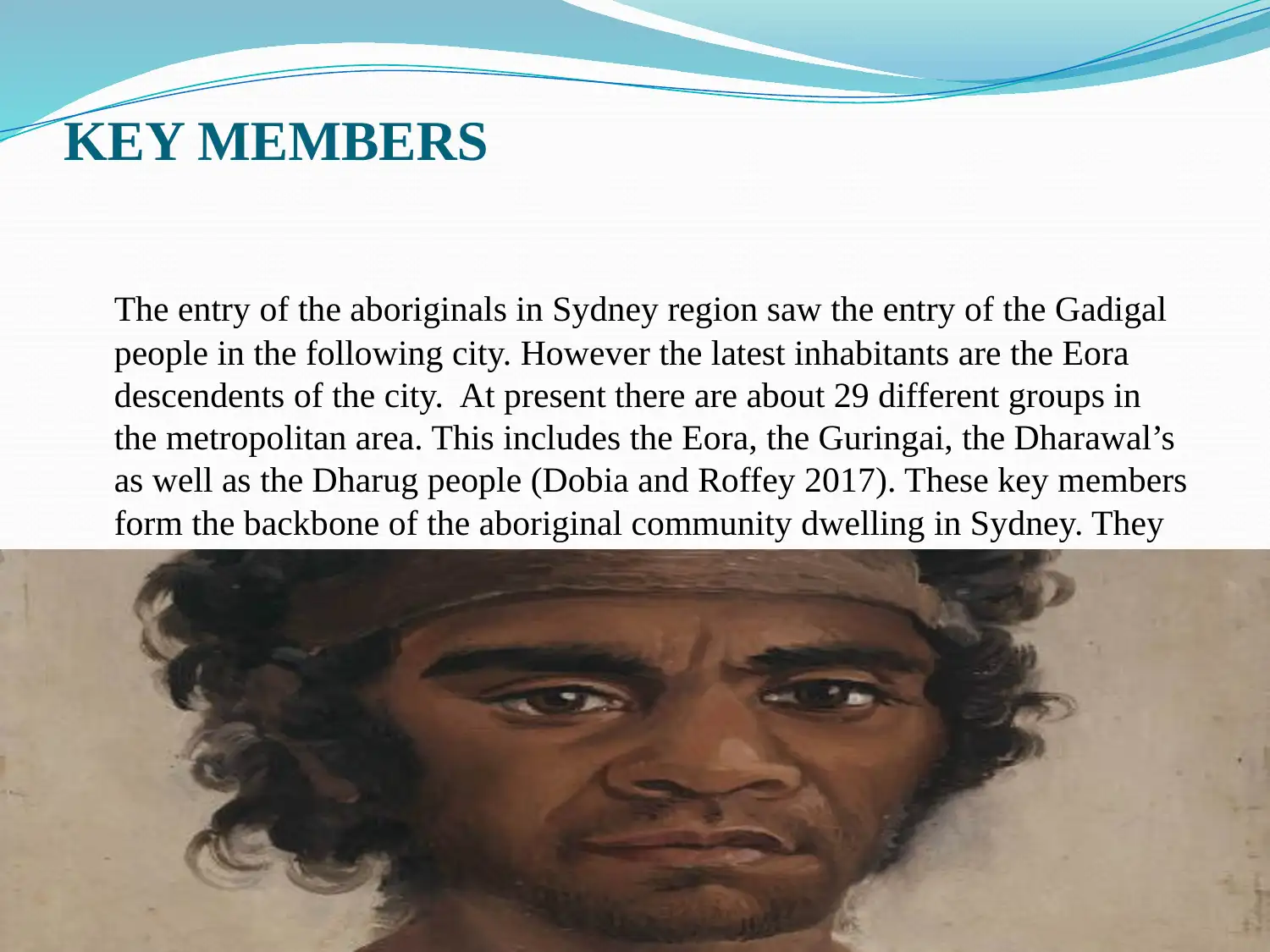
KEY MEMBERS
The entry of the aboriginals in Sydney region saw the entry of the Gadigal
people in the following city. However the latest inhabitants are the Eora
descendents of the city. At present there are about 29 different groups in
the metropolitan area. This includes the Eora, the Guringai, the Dharawal’s
as well as the Dharug people (Dobia and Roffey 2017). These key members
form the backbone of the aboriginal community dwelling in Sydney. They
are supported in different ways by the government as well as the local
authority to help them mix with the community easily.
The entry of the aboriginals in Sydney region saw the entry of the Gadigal
people in the following city. However the latest inhabitants are the Eora
descendents of the city. At present there are about 29 different groups in
the metropolitan area. This includes the Eora, the Guringai, the Dharawal’s
as well as the Dharug people (Dobia and Roffey 2017). These key members
form the backbone of the aboriginal community dwelling in Sydney. They
are supported in different ways by the government as well as the local
authority to help them mix with the community easily.
⊘ This is a preview!⊘
Do you want full access?
Subscribe today to unlock all pages.

Trusted by 1+ million students worldwide
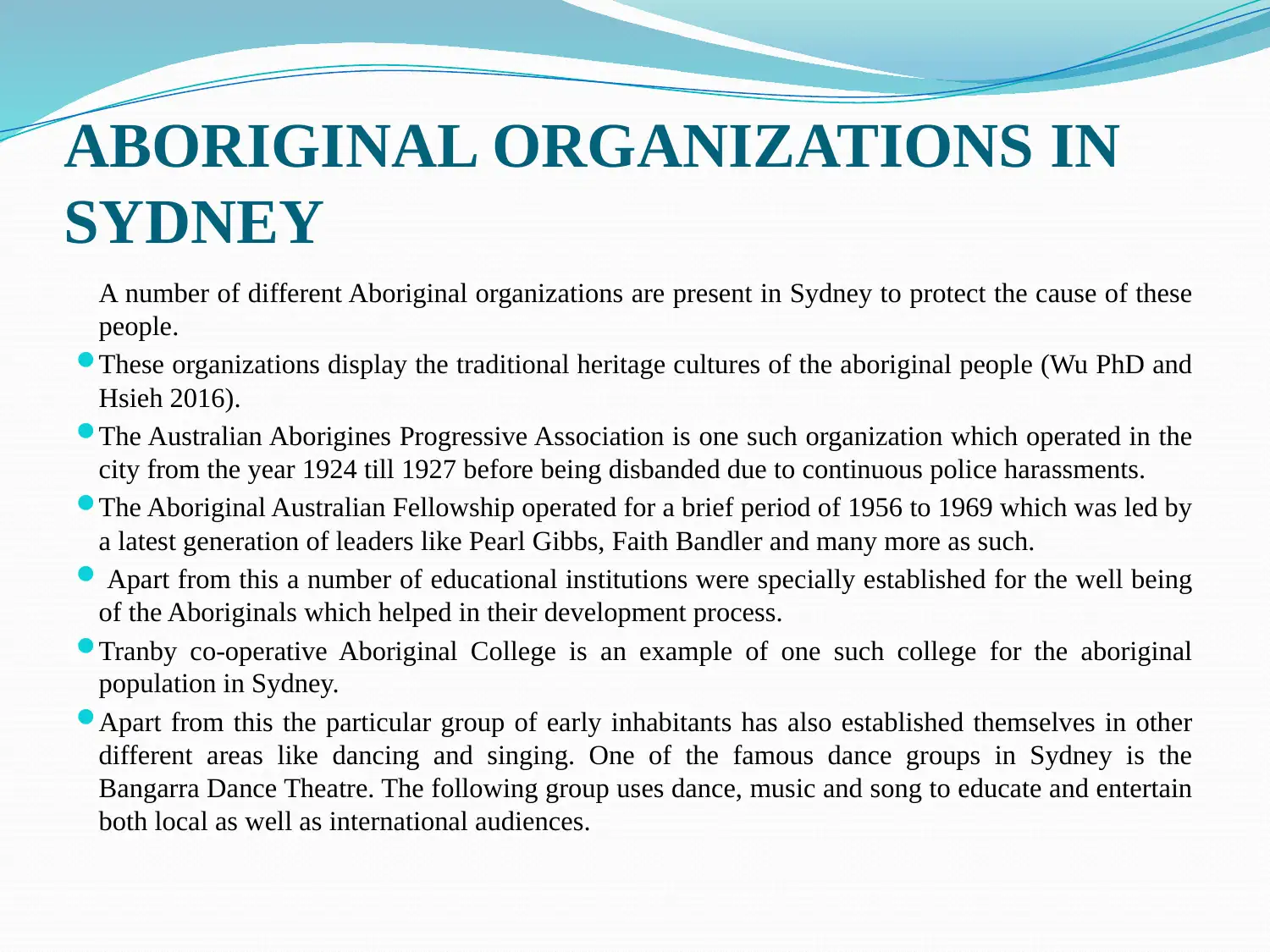
ABORIGINAL ORGANIZATIONS IN
SYDNEY
A number of different Aboriginal organizations are present in Sydney to protect the cause of these
people.
These organizations display the traditional heritage cultures of the aboriginal people (Wu PhD and
Hsieh 2016).
The Australian Aborigines Progressive Association is one such organization which operated in the
city from the year 1924 till 1927 before being disbanded due to continuous police harassments.
The Aboriginal Australian Fellowship operated for a brief period of 1956 to 1969 which was led by
a latest generation of leaders like Pearl Gibbs, Faith Bandler and many more as such.
Apart from this a number of educational institutions were specially established for the well being
of the Aboriginals which helped in their development process.
Tranby co-operative Aboriginal College is an example of one such college for the aboriginal
population in Sydney.
Apart from this the particular group of early inhabitants has also established themselves in other
different areas like dancing and singing. One of the famous dance groups in Sydney is the
Bangarra Dance Theatre. The following group uses dance, music and song to educate and entertain
both local as well as international audiences.
SYDNEY
A number of different Aboriginal organizations are present in Sydney to protect the cause of these
people.
These organizations display the traditional heritage cultures of the aboriginal people (Wu PhD and
Hsieh 2016).
The Australian Aborigines Progressive Association is one such organization which operated in the
city from the year 1924 till 1927 before being disbanded due to continuous police harassments.
The Aboriginal Australian Fellowship operated for a brief period of 1956 to 1969 which was led by
a latest generation of leaders like Pearl Gibbs, Faith Bandler and many more as such.
Apart from this a number of educational institutions were specially established for the well being
of the Aboriginals which helped in their development process.
Tranby co-operative Aboriginal College is an example of one such college for the aboriginal
population in Sydney.
Apart from this the particular group of early inhabitants has also established themselves in other
different areas like dancing and singing. One of the famous dance groups in Sydney is the
Bangarra Dance Theatre. The following group uses dance, music and song to educate and entertain
both local as well as international audiences.
Paraphrase This Document
Need a fresh take? Get an instant paraphrase of this document with our AI Paraphraser
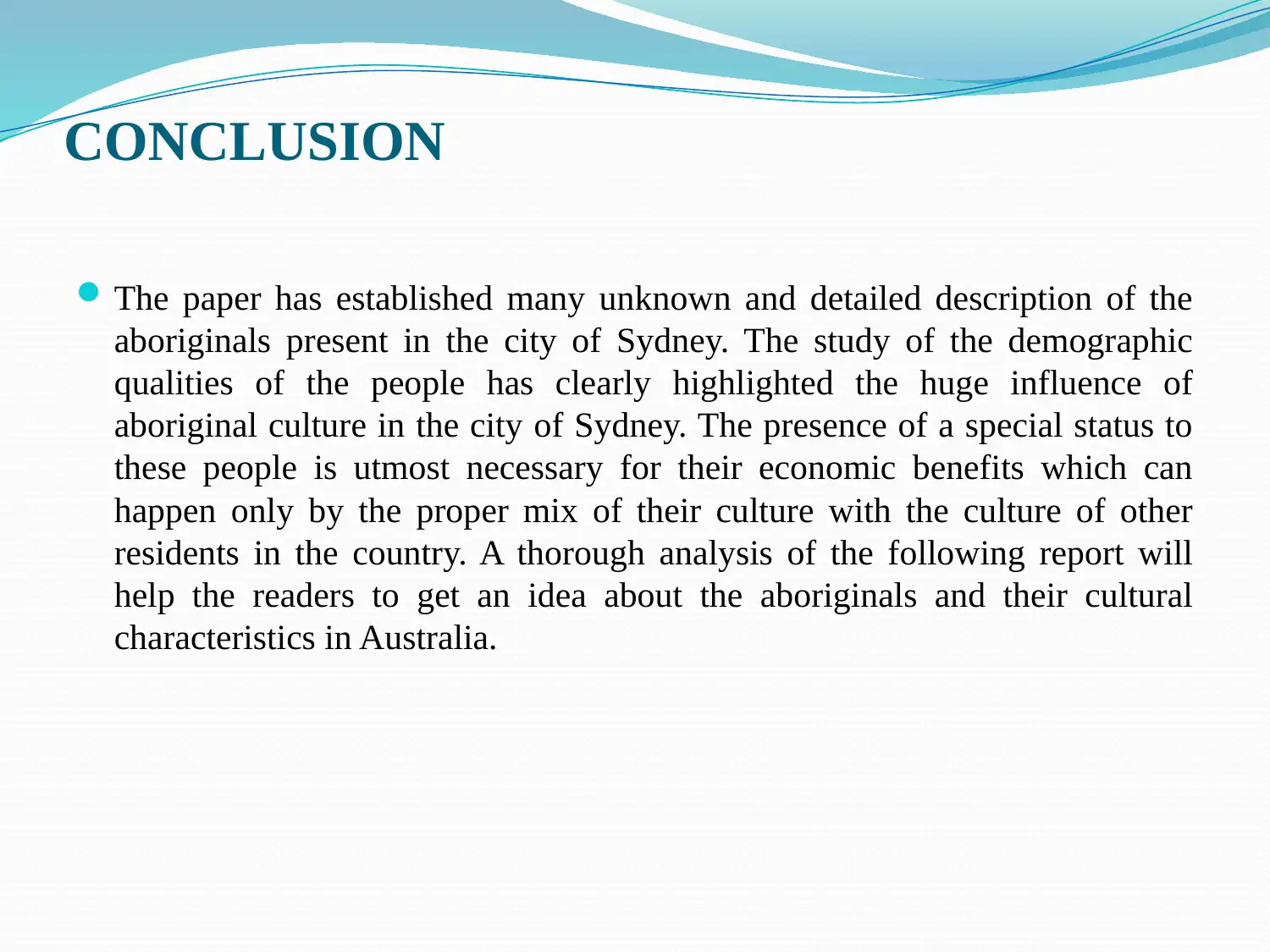
CONCLUSION
The paper has established many unknown and detailed description of the
aboriginals present in the city of Sydney. The study of the demographic
qualities of the people has clearly highlighted the huge influence of
aboriginal culture in the city of Sydney. The presence of a special status to
these people is utmost necessary for their economic benefits which can
happen only by the proper mix of their culture with the culture of other
residents in the country. A thorough analysis of the following report will
help the readers to get an idea about the aboriginals and their cultural
characteristics in Australia.
The paper has established many unknown and detailed description of the
aboriginals present in the city of Sydney. The study of the demographic
qualities of the people has clearly highlighted the huge influence of
aboriginal culture in the city of Sydney. The presence of a special status to
these people is utmost necessary for their economic benefits which can
happen only by the proper mix of their culture with the culture of other
residents in the country. A thorough analysis of the following report will
help the readers to get an idea about the aboriginals and their cultural
characteristics in Australia.
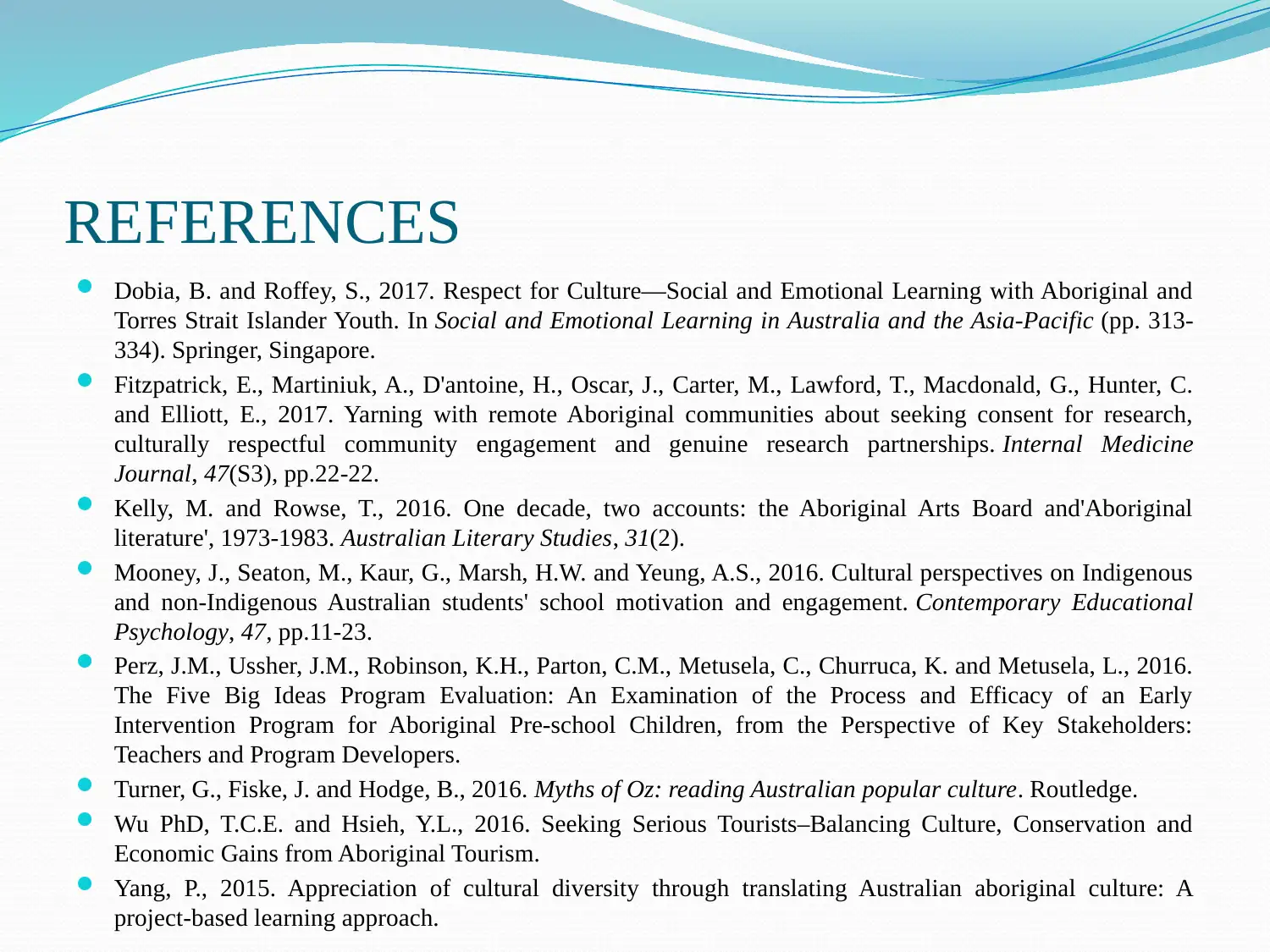
REFERENCES
Dobia, B. and Roffey, S., 2017. Respect for Culture—Social and Emotional Learning with Aboriginal and
Torres Strait Islander Youth. In Social and Emotional Learning in Australia and the Asia-Pacific (pp. 313-
334). Springer, Singapore.
Fitzpatrick, E., Martiniuk, A., D'antoine, H., Oscar, J., Carter, M., Lawford, T., Macdonald, G., Hunter, C.
and Elliott, E., 2017. Yarning with remote Aboriginal communities about seeking consent for research,
culturally respectful community engagement and genuine research partnerships. Internal Medicine
Journal, 47(S3), pp.22-22.
Kelly, M. and Rowse, T., 2016. One decade, two accounts: the Aboriginal Arts Board and'Aboriginal
literature', 1973-1983. Australian Literary Studies, 31(2).
Mooney, J., Seaton, M., Kaur, G., Marsh, H.W. and Yeung, A.S., 2016. Cultural perspectives on Indigenous
and non-Indigenous Australian students' school motivation and engagement. Contemporary Educational
Psychology, 47, pp.11-23.
Perz, J.M., Ussher, J.M., Robinson, K.H., Parton, C.M., Metusela, C., Churruca, K. and Metusela, L., 2016.
The Five Big Ideas Program Evaluation: An Examination of the Process and Efficacy of an Early
Intervention Program for Aboriginal Pre-school Children, from the Perspective of Key Stakeholders:
Teachers and Program Developers.
Turner, G., Fiske, J. and Hodge, B., 2016. Myths of Oz: reading Australian popular culture. Routledge.
Wu PhD, T.C.E. and Hsieh, Y.L., 2016. Seeking Serious Tourists–Balancing Culture, Conservation and
Economic Gains from Aboriginal Tourism.
Yang, P., 2015. Appreciation of cultural diversity through translating Australian aboriginal culture: A
project-based learning approach.
Dobia, B. and Roffey, S., 2017. Respect for Culture—Social and Emotional Learning with Aboriginal and
Torres Strait Islander Youth. In Social and Emotional Learning in Australia and the Asia-Pacific (pp. 313-
334). Springer, Singapore.
Fitzpatrick, E., Martiniuk, A., D'antoine, H., Oscar, J., Carter, M., Lawford, T., Macdonald, G., Hunter, C.
and Elliott, E., 2017. Yarning with remote Aboriginal communities about seeking consent for research,
culturally respectful community engagement and genuine research partnerships. Internal Medicine
Journal, 47(S3), pp.22-22.
Kelly, M. and Rowse, T., 2016. One decade, two accounts: the Aboriginal Arts Board and'Aboriginal
literature', 1973-1983. Australian Literary Studies, 31(2).
Mooney, J., Seaton, M., Kaur, G., Marsh, H.W. and Yeung, A.S., 2016. Cultural perspectives on Indigenous
and non-Indigenous Australian students' school motivation and engagement. Contemporary Educational
Psychology, 47, pp.11-23.
Perz, J.M., Ussher, J.M., Robinson, K.H., Parton, C.M., Metusela, C., Churruca, K. and Metusela, L., 2016.
The Five Big Ideas Program Evaluation: An Examination of the Process and Efficacy of an Early
Intervention Program for Aboriginal Pre-school Children, from the Perspective of Key Stakeholders:
Teachers and Program Developers.
Turner, G., Fiske, J. and Hodge, B., 2016. Myths of Oz: reading Australian popular culture. Routledge.
Wu PhD, T.C.E. and Hsieh, Y.L., 2016. Seeking Serious Tourists–Balancing Culture, Conservation and
Economic Gains from Aboriginal Tourism.
Yang, P., 2015. Appreciation of cultural diversity through translating Australian aboriginal culture: A
project-based learning approach.
⊘ This is a preview!⊘
Do you want full access?
Subscribe today to unlock all pages.

Trusted by 1+ million students worldwide
1 out of 13
Related Documents
Your All-in-One AI-Powered Toolkit for Academic Success.
+13062052269
info@desklib.com
Available 24*7 on WhatsApp / Email
![[object Object]](/_next/static/media/star-bottom.7253800d.svg)
Unlock your academic potential
Copyright © 2020–2025 A2Z Services. All Rights Reserved. Developed and managed by ZUCOL.





